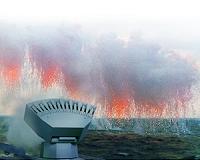| . |  |
. |
Bethpage NY (SPX) Mar 08, 2011 Northrop Grumman's MQ-4C Broad Area Maritime Surveillance Unmanned Aircraft System (BAMS UAS) program conducted system Critical Design Review (CDR) with the U.S. Navy last month. "It is gratifying to see the design mature from the Preliminary Design Review to the Critical Design Review over the past 12 months," said Steve Enewold, Northrop Grumman vice president and program manager for BAMS. "The System Development and Demonstration program's first two fuselages are under construction at our Moss Point, Miss., facility and the first will ship next month to our Palmdale Manufacturing Center in California for final assembly and first flight next year." The MQ-4C system CDR, which was preceded by 10 subsystem and segment CDRs, sets the initial product baseline for the MQ-4C system. The government and Northrop Grumman teams will be working to close out action items which were generated at the review to officially close CDR. The MQ-4C BAMS UAS air vehicle is a marinized version of the U.S. Air Force RQ-4B Global Hawk. Changes to the RQ-4B include a stronger wing, an ice protection system and a sensor suite based upon components of (or entire systems) already fielded in the Department of Defense inventory. "The entire team has done a very thorough and exhaustive job in detail design," said Capt. Bob Dishman, the Navy's BAMS UAS program manager. "Now the program will shift its attention to integration and test with the same level of rigor to ensure we deliver an operationally effective and suitable capability on time and on budget." The MQ-4C CDR was an exhaustive week-long review jointly chaired by both Northrop Grumman and Naval Air Systems Command and included participants from Office of the Secretary of Defense, the Air Force, Office of the Chief of Naval Operations, and Navy fleet representatives from the Maritime Patrol and Reconnaissance Force among many others. During the week, the system design was thoroughly analyzed and Technical Review Board members left with a comprehensive understanding of the program risks as the MQ-4C progresses to its next major milestone, Test Readiness Review which is planned for the fall of this year. The BAMS UAS program continues to meet its acquisition baseline cost, schedule and performance requirements. "Completing CDR is a significant milestone in detailing the system performance projections, interfaces and functionality," said Enewold. "Looking forward, the Navy will get a capability not seen before that will give the operational commander unprecedented knowledge of the ocean surface picture." The Northrop Grumman MQ-4C BAMS UAS is a versatile maritime intelligence, surveillance and reconnaissance aircraft system that will perform maritime missions independently or in direct collaboration with fleet assets. BAMS will play a key role in providing fleet commanders with a persistent, reliable picture of maritime surface contacts, covering vast areas of open ocean and littoral regions in a highly efficient manner. The BAMS UAS program is managed by the Navy's Program Executive Office, Unmanned Aviation and Strike Weapons' Persistent Maritime Unmanned Aircraft Systems Program Office (PMA-262), located at Naval Air Station Patuxent River, Md. The BAMS UAS is the latest addition to a growing family of unmanned systems developed by Northrop Grumman. The BAMS UAS system builds on the company's more than 60 years experience with unmanned aircraft and autonomous flight control, including thousands of flight hours by the combat-proven RQ-4 Global Hawk, the MQ-8B Fire Scout vertical takeoff and landing (VTOL) tactical unmanned system-the first completely autonomous VTOL aircraft to land aboard a Navy vessel underway-and the X-47B Unmanned Combat Air System-the first unmanned air vehicle scheduled to perform carrier landings.
Share This Article With Planet Earth
Related Links - Naval Warfare in the 21st Century
 Full-Speed Ahead For MASS
Full-Speed Ahead For MASSMunich, Germany (SPX) Mar 07, 2011 To protect their fleets from missile attacks, the navies of Peru, Finland and Germany have all ordered MASS, Rheinmetall's "Multi Ammunition Softkill System", a state-of-the-art decoy system for protecting frigates, corvettes, minesweepers and patrol craft. In winning these three orders, MASS has once again outclassed its international rivals as well as gaining a foothold in the South American m ... read more |
|
| The content herein, unless otherwise known to be public domain, are Copyright 1995-2010 - SpaceDaily. AFP and UPI Wire Stories are copyright Agence France-Presse and United Press International. ESA Portal Reports are copyright European Space Agency. All NASA sourced material is public domain. Additional copyrights may apply in whole or part to other bona fide parties. Advertising does not imply endorsement,agreement or approval of any opinions, statements or information provided by SpaceDaily on any Web page published or hosted by SpaceDaily. Privacy Statement |